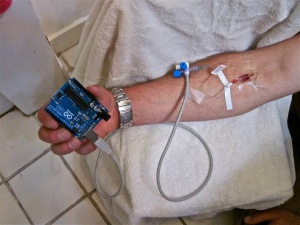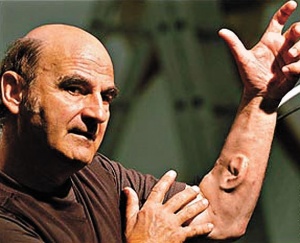User:Emily/Thematic Project/Trimester 01
Adilkno The Media Archive
' Wetware,VR, moist mind '
I has been quite curious about how much human factor can affect on the apparatus, and how much the machinery can work on human body. I can’t remember since when the last thing I touch with my wet fingers before sleeping is always my smartphone and I already cant find the right way without google maps/GPS. Those handy hardware, software become my access to reach the real circumstance. I can’t help thinking will they affect me on a more physiological or psychoactive complexion, or they already did.
As I read the word wetware, it reminded me of a photo from Facebook that I saw long time ago. The only text I got from it is HCI haptic telepathies, which still appeals to the imagination.
[The term "wetware" was coined by Rudy Rucker. He defines it as a collection of technological innovations: chips which are implanted in the brain, organ transplants and prostheses that replace or extend bodily functions. Adilkno considers the wetware idea not as a following phase to upset the wobbly self-image yet again after the revolutions in hard- and software, but as the human remnant which stays behind as the extensions go on longer and longer trips.]
As the saying in text, “wetware is a body attached to machines; wetware means that we have long been connected to the machines surrounding us”,somehow our habits, attitudes in daily life are undergoing a transform, further on we can even re-define our space-time, and shape ourselves in the virtual world. Sometimes ‘the virtual flows seamlessly into actual’, it’s getting harder to tell the boundaries. Then how shall we shape ourselves between both? Like what Roy Ascott puts “Between the dry world of virtuality and the wet world of biology lies a moist domain, a new interspace of potentiality and promise…. A connective mind that is spawning new realities and new definitions of life and human identity. This mind will in turn seek new forms of embodiment and of articulation.”
' The door in Our Consciousness '
- The daily ritual behaviour
- The metaphor of the door
I used to recognise the door as passable way with limitations, which can lead to capacious space or narrow road. I payed attention to both side of the door, the inside and the outside(which can be interchanged), somehow considering what’s the difference between the two side, only overlooked the door itself. Not until it is pointed out that “Its position has always been that you cannot get around it”, I noticed It’s true that I cannot pass without seeing and touching it. But it is totally blur about this daily ritual behaviour in my memory after I passing it, since there are really so many doors we just get in or out everyday. Then in what way I can explore the door “as an object, not a means but an end”?
The first glimpse of the door must maintain a lot of information, western or oriental appearance, massive or diminutive, it bring us to think about its cultural background, and then continually come up with what is the shape of the doorknob, can I open it, should I leave it open…It produce lots of activity not only physically but also in one’s own mind. I think the most concern is its ‘borderline’, since I believe “the door allowed itself to be used as a means to obstruct and control currents”. The contradiction of them interests me. For instance, the door is an obstacle and at the same time we do need this obstacle so much. What’s more, we as the passerby, often switch the place from inside to outside, or the other way around, the door as a tangible media seems play a trick on people.



